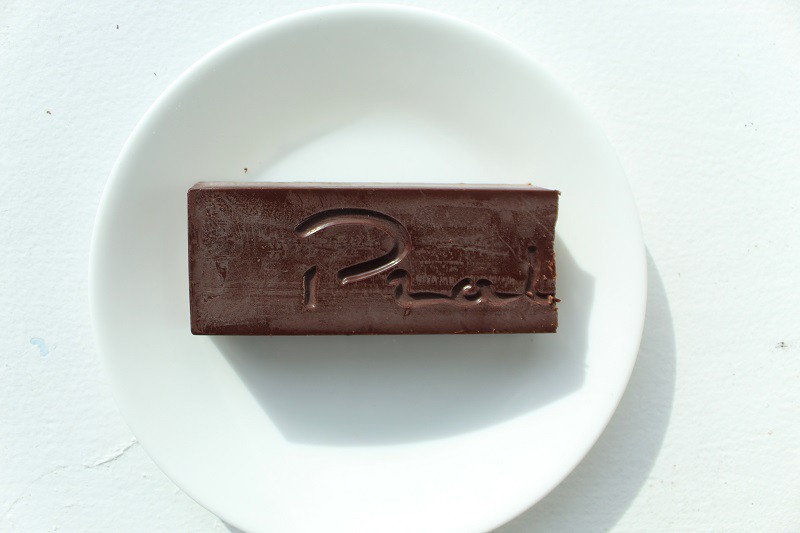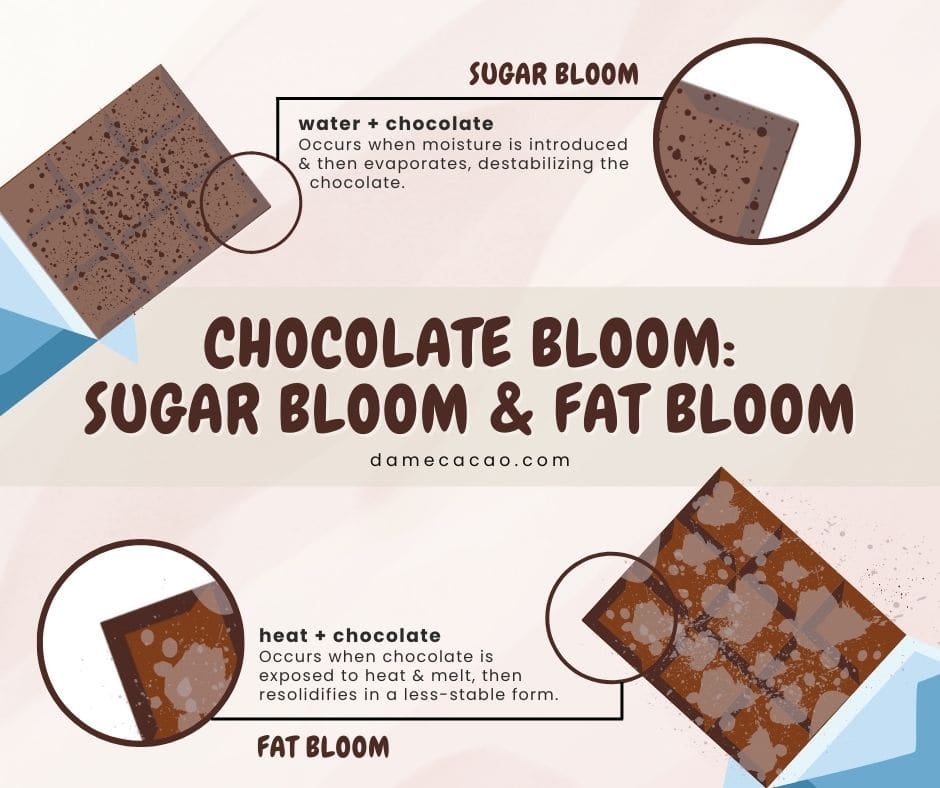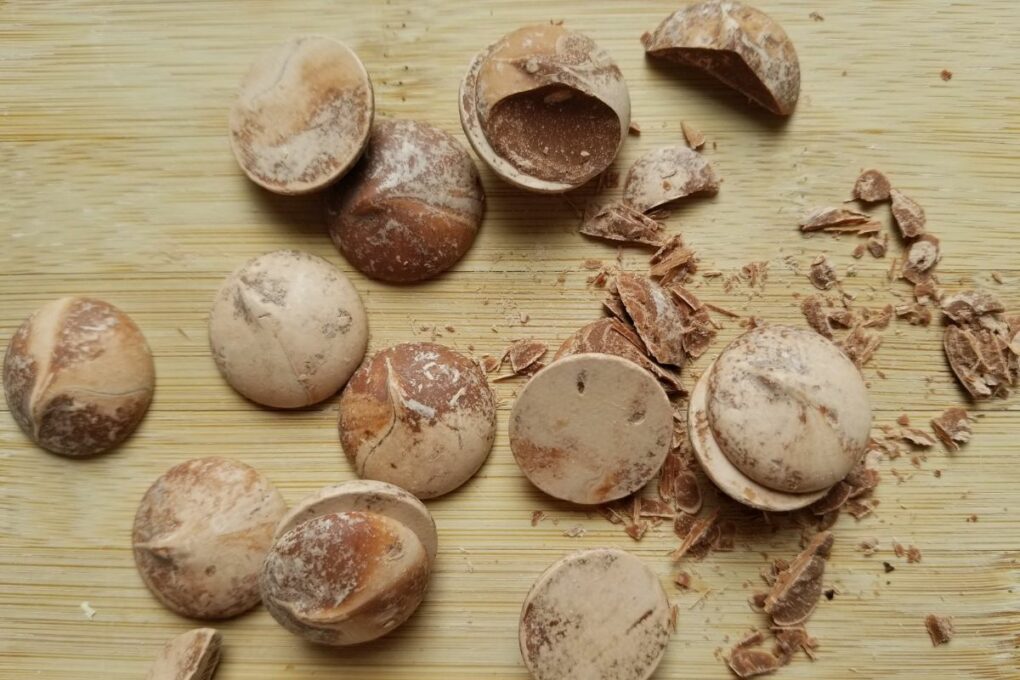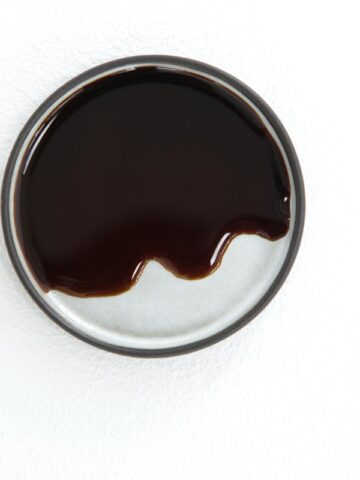When left in less-than-ideal conditions, chocolate bloom can develop and be mistaken for mold. Chocolate can’t grow mold because it’s anhydrous, and can’t hold water, but it can spoil. The white or off-white coloring on the surface of chocolate is what’s referred to as ‘bloom.’
There are two kinds of bloom that can form: fat bloom, which is off-white and smooth, and sugar bloom, which is white and dusty-looking. Light fat blooming can be smudged off the surface of the chocolate; however, the haze and grittiness of sugar bloom are more permanent. In this article we cover every aspect of chocolate bloom, sugar bloom vs fat bloom, and how to fix bloom in chocolate.

Jump To
What is Fat Bloom in Chocolate?
Fat bloom is the off-white color on the surface of chocolate; it’s smooth to the touch. Fat bloom forms when cacao butter loses its stability and migrates within the chocolate. Essentially, fat bloom is cacao butter that has migrated to the surface of the chocolate.
Cacao butter is one of the key ingredients in chocolate. Chocolate liquor is composed of about 50% cacao butter, which can be pressed out to separate the fat and solids (cacao powder). Cacao butter is often added to chocolate liquor to improve the final chocolate’s workability, texture, and durability. It’s solid at 21-24°C (70-75°F) and melts at body temperature, giving chocolate its melt-in-your-mouth consistency.
The solidness of chocolate and the balance of its pleasant characteristics can be credited to the tempering process. It’s a key step in chocolate making which organizes the crystals in cacao butter in a certain way. It involves constantly heating and cooling the chocolate to specific temperatures at which they form the desired crystal structures (form V).
Proper tempering gives chocolate its shine, ease of mold release, smooth texture, and rigidity & snap. Since fat bloom is just cacao butter in the wrong crystal form, proper tempering can resolve it. To avoid fat bloom, store chocolate in a cool, dry place between 18-21℃ (64-69℉) to prevent the cacao butter from melting & migrating.
Compound coating chocolate doesn’t have cacao butter, and instead uses hard vegetable fats like palm oil, making fat bloom less of an issue. However, fillings containing incompatible oils could cause them to migrate to the surface, so even compound chocolate can bloom.

What is Sugar Bloom in Chocolate?
Sugar bloom is the rough white crystals that form across the surface of the chocolate. Sugar bloom occurs when sugar in the chocolate interacts with the water or moisture in the surrounding environment, evaporating and leaving behind rock sugar. These formations occur thanks to a process of crystallization and supersaturation resulting from sugar’s interaction with water.
Chocolate doesn’t mix well with water and moisture. However, the sugar in it does. Water dissolves this sugar, but when the sugar present is greater than the moisture and water, it creates a supersaturated solution wherein sugar crystalizes and bonds with itself.
Chocolate that has sugar bloom can still be consumed; however, it cannot as easily be restored to the way it was. It could be remelted in a double boiler, but the sugar content may have changed, affecting its taste.

How to Prevent Chocolate Bloom
The easiest way to prevent chocolate bloom is to store chocolate properly. The causes of chocolate bloom are rooted in exposure to excessive heat, or moisture in the environment, either of which can result in their formation. Cocoa butter melts at body temperature, so chocolate needs to be stored at a temperature below that threshold to keep it solid.
Storing chocolate in excessively cold environments introduces thermal shocks that can expose it to moisture from condensation. This is especially a concern when chocolate is stored in freezers and refrigerators long-term. To prevent thermal shocks, chocolate needs to be sealed in plastic wrap and paper towels or cloths.
When taken out of storage, it should be given ample time to defrost and acclimate to the ambient temperature. To do this form the freezer, keep it sealed and leave it in the refrigerator for a couple of hours, or set it in a cool dry spot if it was stored in the fridge.

How to Fix Chocolate Bloom
Between chocolate that has fat bloomed or sugar bloomed, fat bloom is the most reliably recovered. Both fat- and sugar-bloomed chocolate are perfectly edible, but the appearance is not suitable for molded chocolates. Since fat bloom is just displaced cacao butter, the chocolate can be remelted and tempered using a double boiler or the microwave method.
However if the chocolate contains inclusions or fillings, it cannot be recovered, and that batch is ruined. As for chocolate with sugar bloom, the transformation of the sugar crystals cannot be reversed. It can still be re-melted and consumed, but its taste, texture, and consistency are adversely affected, so it’s no longer good for shaping in molds and enrobing.
If the bloom is light and can be scraped off, it may be salvageable. Some even recommend using a bit of water to dissolve the sugar crystals. However, if the chocolate has moderate sugar bloom, it’s unrecoverable and should be used in baking or consumed, instead.

FAQ on Chocolate Bloom
Chocolate bloom a whitish layer on chocolate’s surface, often mistaken for mold. There are two types of chocolate bloom: fat bloom, which is a change in crystal structure of cacao butter in the chocolate, and sugar bloom, which is the crystallization of sugar in the chocolate, caused by moisture.
Yes. Despite the changes in appearance, bloomed chocolate is perfectly safe to eat. Fat bloom is essentially chocolate that has lost its temper and will no longer have the right texture and shine. Sugar-bloomed chocolate’s dry and dull appearance is due to transformed sugar crystals, but will still taste fine.
To prevent bloom from forming, chocolate needs to be stored properly. Chocolate needs to be stored in a cool, dry place to keep the cacao butter from melting, with humidity levels below 50%. When moving chocolate from a cold zone to a warm one, keep it sealed and do not open the packaging. This allows chocolate time to acclimate to the ambient temperature, to prevent condensation from forming.
The separation of cacao butter and sugar when exposed to heat and moisture is immediate, but it may take hours for the bloom to be visible, as the fats need to migrate and sugar to crystalize. It’s best to just take preventive steps to keep bloom from forming in the first place.

















Comments
No Comments